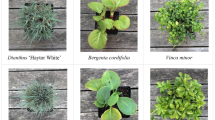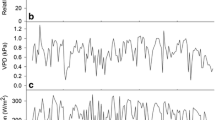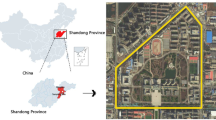Abstract
Soil sealing and a decrease in vegetation cover in urban areas increase the likelihood and frequency of localised flooding. Populating the remaining green areas with vegetation, which can efficiently capture excess rainfall, is therefore important. We argue that urban hedges can be a useful tool in mitigating rainfall, so the understanding of optimal plant choice, and underlying traits which enable most rain attenuation, is needed. We tested the hypothesis that higher plant evapo-transpiration rates and larger canopy size can be linked with reduced rainfall runoff in urban hedge species. We first characterised seven hedge species grown in individual containers. These were both deciduous and evergreen species, with a range of inherent canopy sizes and water requirements. We assessed their plant water use, leaf stomatal conductance, canopy rainfall retention, and runoff delay and reduction capacity. The species showing highest and lowest potential for runoff reduction were then investigated for their outdoor performance, when planted in a hedge-like form. Our findings suggest that—after 3 days between rainfall events—species such as Cotoneaster and Crataegus with larger and wide canopies, and with high evapo-transpiration/water use rates, delayed the start of runoff (by as much to 10–15 min compared to bare substrate) as well reduced the volume of rainfall runoff. For example, < 5% of the applied rainfall had runoff with Cotoneaster and Crataegus, compared with > 40% in bare substrate. Substrate moisture content at the time of rainfall (which is linked to plants’ ET rate) was the key explanatory variable.


Similar content being viewed by others
References
Anon (2016) How green are British front gardens? Ipsos MORI. https://www.ipsos-mori.com/researchpublications/researcharchive/3738/How-green-are-British-front-gardens.aspx. Accessed 29 Nov 2016
Asadian Y, Weiler M (2009) A new approach in measuring rainfall interception by urban trees in coastal British Columbia. Water Qual Res J Can 44(1):16
Bartens J, Day SD, Harris JR, Dove JE, Wynn TM (2008) Can urban tree roots improve infiltration through compacted subsoils for stormwater management? J Environ Qual 37(6):2048–2057
Berretta C, Poë S, Stovin V (2014) Moisture content behaviour in extensive green roofs during dry periods: the influence of vegetation and substrate characteristics. J Hydrol 511:374–386
Blanusa T, Vaz Monteiro MM, Fantozzi F, Vysini E, Li Y, Cameron RWF (2013) Alternatives to Sedum on green roofs: can broad leaf perennial plants offer better ‘cooling service’? Build Environ 59:99–106. https://doi.org/10.1016/j.buildenv.2012.08.011
Blanusa T, Fantozzi F, Monaci F, Bargagli R (2015) Leaf trapping and retention of particles by holm oak and other common tree species in Mediterranean urban environments. Urban For Urban Green 14(4):1095–1101. https://doi.org/10.1016/j.ufug.2015.10.004
Blanusa T, Hadley J, Hunt L, Alexander P, Hobbs K (2017) Provision of ecosystem services by hedges in urban domestic gardens: focus on rainfall mitigation. Acta Hortic 1189:519–523
Cameron RWF, Blanuša T (2016) Green infrastructure and ecosystem services is the devil in the detail? Ann Bot 118(3):377–391. https://doi.org/10.1093/aob/mcw129
Cameron R, Hitchmough J (2016) New green space interventions-green walls, green roofs and rain gardens. Environmental horticulture: science and management of green landscapes. CAB Int, Boston, pp 260–283
Cameron RWF, Blanusa T, Taylor JE, Salisbury A, Halstead AJ, Henricot B, Thompson K (2012) The domestic garden its contribution to urban green infrastructure. Urban For Urban Green 11(2):129–137
Carlyle-Moses D (2004) Throughfall, stemflow, and canopy interception loss fluxes in a semi-arid Sierra Madre Oriental matorral community. J Arid Environ 58(2):181–202
Carlyle-Moses DE, Gash JH (2011) Rainfall interception loss by forest canopies. In: Levia DF, Carlyle-Moses D, Tanaka T (eds) Forest hydrology and biogeochemistry. Springer, New York, pp 407–423
Charlesworth SM (2010) A review of the adaptation and mitigation of global climate change using sustainable drainage in cities. J Water Clim Change 1(3):165–180. https://doi.org/10.2166/wcc.2010.035
Clarke MA, Walsh RPD (2007) A portable rainfall simulator for field assessment of splash and slopewash in remote locations. Earth Surf Process Landf 32(13):2052–2069. https://doi.org/10.1002/esp.1526
Crockford R, Richardson D (2000) Partitioning of rainfall into throughfall, stemflow and interception: effect of forest type, ground cover and climate. Hydrol Process 14(16–17):2903–2920
Fister W, Iserloh T, Ries JB, Schmidt RG (2012) A portable wind and rainfall simulator for in situ soil erosion measurements. CATENA 91:72–84. https://doi.org/10.1016/j.catena.2011.03.002
Ford ED, Deans JD (1978) The effects of canopy structure on stemflow, throughfall and interception loss in a young sitka spruce plantation. J Appl Ecol 15(3):905–917. https://doi.org/10.2307/2402786
Gaston KJ, Warren PH, Thompson K, Smith RM (2005) Urban Domestic Gardens (IV): the Extent of the Resource and its Associated Features. Biodivers Conserv 14(14):3327–3349
Ghazavi G, Thomas Z, Hamon Y, Marie J-C, Corson M, Merot P (2008) Hedgerow impacts on soil-water transfer due to rainfall interception and root-water uptake. Hydrol Process 22(24):4723–4735
Herbst M, Roberts JM, Rosier PTW, Gowing DJ (2006) Measuring and modelling the rainfall interception loss by hedgerows in southern England. Agric For Meteorol 141(2–4):244–256. https://doi.org/10.1016/j.agrformet.2006.10.012
Holder CD (2013) Effects of leaf hydrophobicity and water droplet retention on canopy storage capacity. Ecohydrology 6(3):483–490
Humphry JB, Daniel TC, Edwards DR, Sharpley AN (2002) A portable rainfall simulator for plot-scale runoff studies. Appl Eng Agric 18(2):199–204
Iserloh T, Fister W, Seeger M, Willger H, Ries JB (2012) A small portable rainfall simulator for reproducible experiments on soil erosion. Soil Tillage Res 124:131–137. https://doi.org/10.1016/j.still.2012.05.016
Keim R, Skaugset A, Weiler M (2006) Storage of water on vegetation under simulated rainfall of varying intensity. Adv Water Resour 29(7):974–986
Kelly D (2018) Impact of paved front gardens on current and future urban flooding. Journal of Flood Risk Manag 11(S1):434–443
Kemp S (2018) Impact of plant choice and water management on the provision of ecosystem services by green roofs. Dissertation, University of Reading, UK
Kemp S, Blanusa T, Hadley P (2017) Greywater impact on green roofs’ provision of ecosystem services. Acta Hortic 1189:513–518
Kemp S, Hadley P, Blanuša T (2019) The influence of plant type on green roof rainfall retention. Urban Ecosyst 22(2):355–366
Liu S (1998) Estimation of rainfall storage capacity in the canopies of cypress wetlands and slash pine uplands in North-Central Florida. J Hydrol 207(1–2):32–41
Mueller GD, Thompson AM (2009) The ability of urban residential lawns to disconnect impervious area from municipal sewer systems. J Am Water Resour Assoc 45(5):1116–1126
Nordén U (1991) Acid deposition and throughfall fluxes of elements as related to tree species in deciduous forests of South Sweden. Water Air Soil Pollut 60(3):209–230
O’Sullivan OS, Holt AR, Warren PH, Evans KL (2017) Optimising UK urban road verge contributions to biodiversity and ecosystem services with cost-effective management. J Environ Manag 191:162–171
Owens MK, Lyons RK, Alejandro CL (2006) Rainfall partitioning within semiarid juniper communities: effects of event size and canopy cover. Hydrol Process 20(15):3179–3189
Perry T, Nawaz R (2008) An investigation into the extent and impacts of hard surfacing of domestic gardens in an area of Leeds, United Kingdom. Landsc Urban Plan 86(1):1–13
Pit R, Lantrip J, Harrison R, Henry CL, Xue D (1999) Infiltration through disturbed urban soils and compost-amended soil effects on runoff quality and quantity. National Risk Management Research Laboratory, Washington
Poë S, Stovin V, Berretta C (2015) Parameters influencing the regeneration of a green roof’s retention capacity via evapotranspiration. J Hydrol 523:356–367
Roloff A, Korn S, Gillner S (2009) The climate-species-matrix to select tree species for urban habitats considering climate change. Urban For Urban Green 8(4):295–308. https://doi.org/10.1016/j.ufug.2009.08.002
Scharenbroch BC, Morgenroth J, Maule B (2016) Tree species suitability to bioswales and impact on the urban water budget. J Environ Qual 45(1):199–206
Smith C (2010) London: Garden city? London Wildlife Trust, Greenspace Information for Greater London, Greater London Authority, London
Stovin V, Vesuviano G, Kasmin H (2012) The hydrological performance of a green roof test bed under UK climatic conditions. J Hydrol 414:148–161
Toba T, Ohta T (2005) An observational study of the factors that influence interception loss in boreal and temperate forests. J Hydrol 313:208–220
Vaz Monteiro M, Blanuša T, Verhoef A, Richardson M, Hadley P, Cameron RWF (2017) Functional green roofs: importance of plant choice in maximising summertime environmental cooling and substrate insulation potential. Energy Build 141:56–68. https://doi.org/10.1016/j.enbuild.2017.02.011
Verbeeck K, Van Orshoven J, Hermy M (2011) Measuring extent, location and change of imperviousness in urban domestic gardens in collective housing projects. Landsc Urban Plan 100(1):57–66
Warhurst JR, Parks KE, McCulloch L, Hudson MD (2014) Front gardens to car parks: changes in garden permeability and effects on flood regulation. Sci Total Environ 485:329–339
Xiao Q, McPherson EG (2002) Rainfall interception by Santa Monica’s municipal urban forest. Urban Ecosyst 6(4):291–302
Acknowledgements
The authors are grateful to Paul Mealey for designing and producing rainfall simulators, Kevin Hobbs at Hillier Nurseries for the supply of plants, Matthew Richardson, Will Johnson, Val Jasper, Julia Janes, Michael Dawes, Curtis Gubb for expert technical help, Alessandro Leidi for statistical support and Dr Sarah Kemp, Dr Andrew Daymond, Dr Paul Alexander and Leigh Hunt for constructive discussions.
Funding
Funded by Royal Horticultural Society.
Author information
Authors and Affiliations
Corresponding author
Rights and permissions
About this article
Cite this article
Blanusa, T., Hadley, J. Impact of plant choice on rainfall runoff delay and reduction by hedge species. Landscape Ecol Eng 15, 401–411 (2019). https://doi.org/10.1007/s11355-019-00390-x
Received:
Revised:
Accepted:
Published:
Issue Date:
DOI: https://doi.org/10.1007/s11355-019-00390-x




